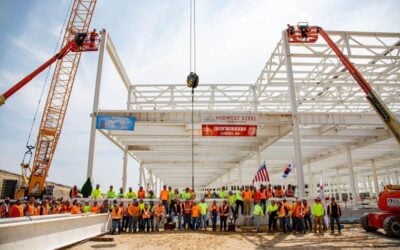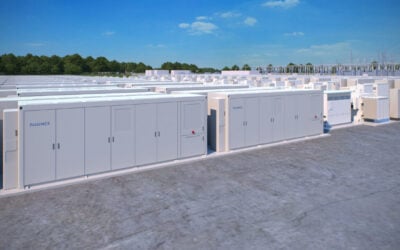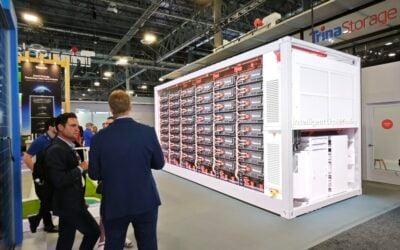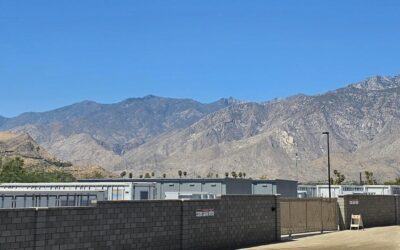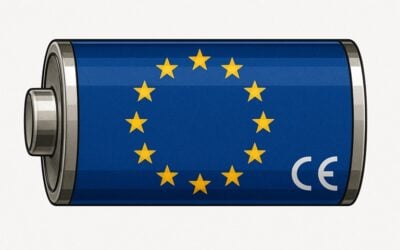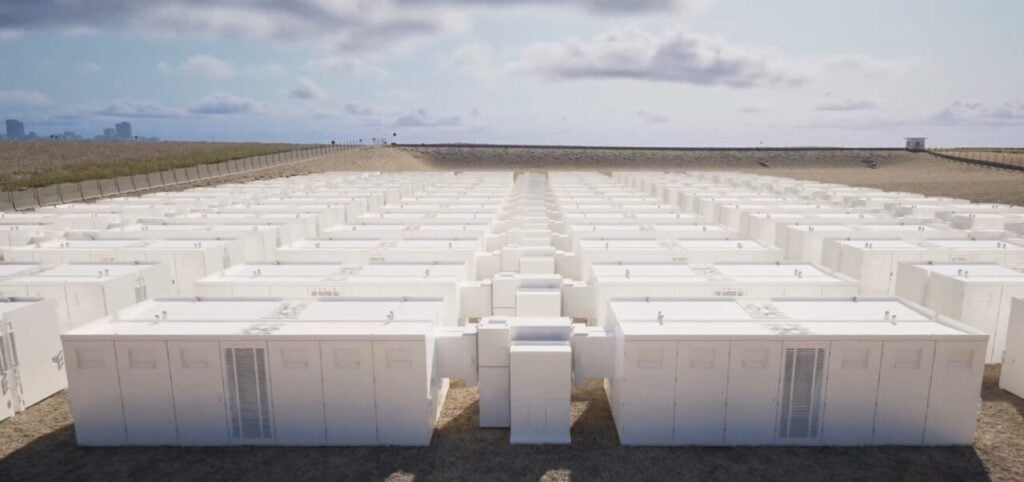
Tesla reported record energy storage deployments and business segment profits in Q3 2025, just ahead of a shareholder vote on CEO Elon Musk’s historic remuneration package.
The US electric vehicle (EV), energy storage, software and robotics company reported its third quarter results last week (22 October), in which it also reported record vehicle deliveries.
Tesla made 12.5GWh of energy storage deployments in the quarter across the residential, commercial & utility (C&I) and utility-scale market segments, an 81% increase from the same period last year when it delivered 6.9GWh.
Total revenues for the period were just over US$28 billion, representing a 12% year-on-year increase from Q3 2024’s US$25.18 billion and a 25% increase from US$22.5 billion in Q2 2025.
Try Premium for just $1
- Full premium access for the first month at only $1
- Converts to an annual rate after 30 days unless cancelled
- Cancel anytime during the trial period
Premium Benefits
- Expert industry analysis and interviews
- Digital access to PV Tech Power journal
- Exclusive event discounts
Or get the full Premium subscription right away
Or continue reading this article for free
Of the quarterly total, US$3.4 billion came from energy generation and storage, versus US$21.2 billion from Tesla’s automotive segment.
According to the company’s Form 10Q filed with the US Securities and Exchange Commission (SEC), for the nine months ending 30 September 2025, both total revenues and profits fell year-on-year, however.
Total revenue fell 2.9% from US$72 billion in January-September 2024 to US$69.9 billion for the equivalent period this year, and gross profit by 9%, from US$13.27 billion to US$12.09 billion.
As reported by our colleagues at EV Infrastructure News (EVIN), Tesla’s profitability took a hit due to higher operating costs and lower regulatory credit income in the US, offsetting the impact of a rush to buy EVs before US tax credits expired at the end of September.
US trade tariffs caused a rise in manufacturing costs, although the company said it was “difficult to measure the impacts of shifting global trade and fiscal policies” on vehicle sales. The removal of fines for non-compliance with emissions standards has also removed the market for selling carbon emissions credits to other automakers.
Within its energy generation and storage division, however, revenues grew 27% year-on-year between the first nine months of each year, and despite a 21% increase in the cost of revenues, gross profit was US$2.7 billion in the segment, with a gross margin of 30.3%, up from US$1.87 billion and a 26.6% gross margin last year.
Gross margin for the reported quarter in the energy division was 31.4% due to a gross profit of US$1.07 billion, compared to 17% gross margin for automotive and 18% gross margin overall.
Megapack 4 to ‘incorporate a lot of what is normally in a substation’
During the quarter, Tesla launched Megablock, which features Megapack 3, the newest iteration of the company’s Megapack utility-scale BESS solution. Megablock allows users to put four 5MWh Megapack 3 units together to create a 20MWh solution, with Tesla claiming a site-level density of 248MWh AC-per-acre on its launch in September during the RE+ trade show in Las Vegas.
CEO Elon Musk said in an earnings call to explain results that Tesla has “exciting plans for Megapack 4,” which he said will “incorporate a lot of what is normally in a substation,” able to output at “probably 35kV directly”.
“So, this greatly improves our ability to deploy Megapack because it’s not dependent on building a substation up through 35 kV for Megapack 4,” Musk said, calling this “the engineering priority for Megapack.”
Michael Snyder, Tesla VP of energy and charging, said demand for Megapack and the residential Powerwall battery storage system “continues to be really strong into next year.”
Snyder claimed the company had already received “very strong positive customer feedback on our Megablock product, which will begin shipping next year out of Houston.”
As is becoming a common theme in the industry of late, Snyder said Tesla foresaw potential demand for large-scale battery storage arising from AI and data centre applications, “as hyperscalers and utilities have seen the versatility of the Megapack product to increase reliability and receive—and relieve grid constraints.”
However, as Tesla CFO Vaibhav Taneja pointed out, while the energy storage business delivered record deployments, gross profit and margins in the third quarter, the segment sees a bigger percentage of cost of goods sold (COGS) impact from tariffs than its automotive division.
This is because all battery cells procured for its stationary storage products are sourced from China while the company works on alternative sources, Taneja said. The ramp-up of its recently opened Megafactory in Shanghai, China, which makes the grid-scale systems for delivery to non-US customers, is helping the company reduce its exposure to tariffs, Taneja said. The company said in its previous results release that it will start lithium iron phosphate (LFP) cell production in the US, expected to commence before the end of this year.
The overall tariff impact on quarterly revenues was in excess of US$400 million, the CFO said, generally split evenly between EVs and BESS.
Vote on Musk’s remuneration imminent
The earnings call focused mainly on the automotive segment, including full self-driving and Tesla’s Robotaxi offerings, while self-styled Tesla ‘Technoking’ Musk’s own comments emphasised activities in the AI space and the humanoid robot the company is developing.
There was also some discussion of the proposed US$1 trillion pay package that Musk will receive contingent upon Tesla meeting specific performance targets. Shareholders will vote on the package in a few days, with voting closing at 11.59pm ET on 5 November, ahead of the Annual Meeting the next day.
The package would include an equity award, which would vest after 7.5 and 10 years based on whether Tesla’s market cap—currently at around a trillion-and-a-half dollars—goes beyond US$2 trillion, on a sliding scale up to US$8.5 trillion.
CFO Taneja said the meeting would “shape the future of Tesla,” and said the board requested that shareholders “support Elon’s leadership” through the two compensation proposals on the table, as well as endorse the re-election of three board members, Ihra Ehrenpreis, Kathleen Wilson-Thompson and Joe Gebbia.
However, the compensation package would not only richly reward Musk financially if 12 targets are met, but would also allow the CEO to retain the control he claimed he should have: “but not so much that I can’t be fired if I go insane,” he said.
The CEO said something about not wanting to “build a robot army and then be ousted” over recommendations from the likes of ISS and Glass Lewis, two proxy advisory firms on corporate governance, which Musk went on to describe as “corporate terrorists”.
Both have been vocal in recommending that shareholders vote against the pay package, which was put in place after a 2018 deal was recently struck down in a Delaware court as “deeply flawed.” ISS and Glass Lewis said the deal would be excessive, dilute shareholder value and would not align with long-term investor interests.
Tesla board chair Robyn Denholm sent a letter to shareholders yesterday (27 October), on behalf of fellow board members and the company’s executive directors, urging shareholders to greenlight the proposals.
“When negotiating this performance award, we necessarily considered what Tesla’s future without Elon would look like, and we did not believe it was the future that our shareholders deserve,” Denholm wrote.
“At a time when companies—both big and small—are competing to be the first to bring groundbreaking AI technologies to market, we could not risk losing the best leader in the industry to put Tesla on top. Now is a pivotal moment for our company to emerge as a leader in AI, and with our exceptional CEO at the helm, we are perfectly positioned to seize it.”
However, the views of shareholders submitted to the SEC this week varied. The State Board of Administration of Florida (SBA) said it would vote ‘yes’, citing the benefits to investors in terms of value creation if the plan’s metrics are met.
On the other hand, New York State Common Retirement Fund trustee Thomas DiNapoli, the state comptroller for New York, said he was “deeply concerned about the continued entrenchment, weak governance, and lack of accountability at Tesla,” and said the board was operating with “an alarming lack of independence.”
DiNapoli said the board of directors, including the three members up for re-election had “consistently allowed CEO Musk’s inattention to corporate affairs and his unpredictable and highly public actions to damage Tesla’s reputation, operational stability, and investor confidence,” while also citing the company’s volatile share performance over the past year—plummeting from highs of US$488 in December 2024 to US$222 per share in March—and declining EV market share among reasons to vote down the compensation package and re-elections.
Conference call transcript by Seeking Alpha.

